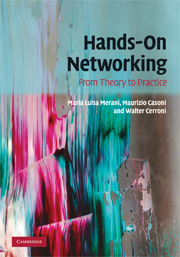6 - Routes
Published online by Cambridge University Press: 05 June 2012
Summary
In the previous chapters, a few network devices have been presented. Repeaters are layer-1 devices that perform functions related to physical signal processing. Bridges are layer-2 devices that are able to detect frames and interpret their fields, such as MAC addresses. A switch is a multiport bridge, still a layer-2 device, but with high frame-processing performance.
Even if LAN interconnections in wide areas may be done by using bridges, and until the early 1990s this was quite common, the best way for managing wide area connections is through layer-3 devices, usually called routers. Routers perform all functions from layer-1 up to layer-3: they can process packets and are the main devices for network layer management. Indeed, routers represent the most important intermediate systems used to interconnect heterogeneous networks on a geographical scale, building a consistent and cooperative complex system commonly known as an internet.
This chapter illustrates the main concepts behind IP-based routers, discussing the most important functions performed and describing the most common architectures available. Some details of the IP packet processing and forwarding operations are provided, followed by the description of more advanced network layer functionalities, such as packet filtering and address translation. The chapter is concluded by a few practical configuration examples.
What is a router?
A possible way to start presenting routers is to try to compare them with bridges [65]. A bridge physically connects different LANs but, actually, they can be logically considered the same network, with the same network rules and the same network protocol. A router, on the other hand, completely separates LANs and networks, both physically and logically.
- Type
- Chapter
- Information
- Hands-On NetworkingFrom Theory to Practice, pp. 161 - 186Publisher: Cambridge University PressPrint publication year: 2009



